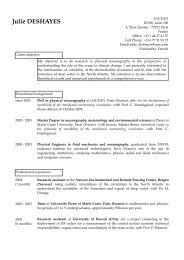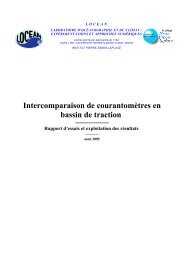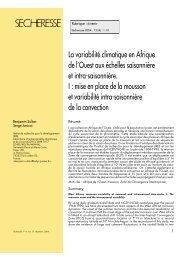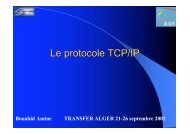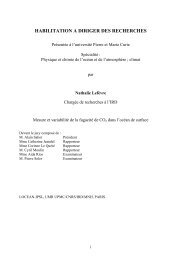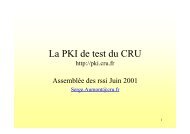PISCES biogeochemical model - NEMO
PISCES biogeochemical model - NEMO
PISCES biogeochemical model - NEMO
You also want an ePaper? Increase the reach of your titles
YUMPU automatically turns print PDFs into web optimized ePapers that Google loves.
3.9 Equation for biogenic silica<br />
∂BSi<br />
∂t<br />
= m diat D<br />
K diat + D DSi + wP<br />
diat DD Si<br />
( ) D<br />
+(g micro (D)Z + g meso Si<br />
(D)M) − λ ⋆<br />
D<br />
BSiBSi<br />
−w P OC ∂BSi<br />
b<br />
∂z<br />
The dissolution rate of BSi depends on in situ temperature and on saturation following the<br />
parameterization proposed by Ridgwell et al., 2003 :<br />
968<br />
6.44−<br />
Si eq = 10 T +273.15<br />
Si sat = Si eq − Si<br />
Si eq<br />
⎡<br />
(<br />
λ ⋆ BSi = λ BSi<br />
⎣0.225 1 + T )<br />
( (<br />
Si sat + 0.775 1 + T ) 4<br />
) ⎤ 9<br />
Si sat<br />
⎦ (24)<br />
15<br />
400<br />
3.10 Equations for particulate organic iron<br />
To make the document clearer, the equations are not detailed here. The reader could refer<br />
to the equations for particulate organic carbon (see Equations 20) as the sources and sinks are<br />
pretty much the same as for PFe.<br />
(23)<br />
3.11 Equation for calcite<br />
∂CaCO 3<br />
∂t<br />
= R CaCO3 (0.5(σ micro g micro (P ) + σ meso g meso (P )M) + w nano<br />
P P 2<br />
+m nano P<br />
K nano + P P ) − λ⋆ CaCO3 CaCO 3 − w P OC ∂CaCO b 3<br />
∂z<br />
In this equation, the rain ratio R CaCO3 is variable. The proportion of calcifying phytoplankton<br />
is generally very low in oligotrophic regions. When the nanophytoplankton blooms, the<br />
dominant species are often calcifiers. To mimic these very general considerations, we propose<br />
the following parameterizations which is similar to that of Moore et al. (2003):<br />
R CaCO3 = R ⋆ CaCO3L nano<br />
lim<br />
max<br />
(<br />
0.0001,<br />
T<br />
2 + T<br />
)<br />
max<br />
The rain ratio is not allowed to fall below 0.01 and to exceed 0.8.<br />
(<br />
1, P 2<br />
Only half of the grazed shells is routed to sinking calcite. The rest is supposed to dissolve in<br />
the acidic guts of zooplankton. This dissolution is still highly debated. However, observations<br />
tend to show that a significant proportion of the sinking shells is lost in the upper ocean,<br />
whether during grazing or by other mechanisms.<br />
The dissolution rate constant is defined as follows:<br />
∆CO3 = max(0, CO3 2−<br />
sat − CO3 2− )<br />
λ ⋆ CaCO3 = λ CaCO3<br />
∆CO3<br />
K CaCO3 + ∆CO3<br />
9<br />
)<br />
(25)<br />
(26)<br />
(27)





